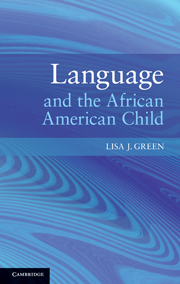Book contents
- Frontmatter
- Contents
- Figures
- Tables
- Foreword
- Preface
- Note on the text
- 1 Child AAE: an introductory overview of the data and context
- 2 Characterizing AAE: feature lists, dual components, and patterns and systems
- 3 System of tense–aspect marking 1: non-past and habitual
- 4 System of tense–aspect marking 2: past time
- 5 Negation: focus on negative concord
- 6 Asking questions: seeking clarification and requesting elaboration
- 7 Variation: intra-dialectal/variable-shifting and inter-dialectal/code-shifting
- 8 The D.I.R.E.C.T. Model: linking linguistic description and education
- Appendix A: List of participants
- Appendix B
- Notes
- References
- Index
4 - System of tense–aspect marking 2: past time
Published online by Cambridge University Press: 05 June 2012
- Frontmatter
- Contents
- Figures
- Tables
- Foreword
- Preface
- Note on the text
- 1 Child AAE: an introductory overview of the data and context
- 2 Characterizing AAE: feature lists, dual components, and patterns and systems
- 3 System of tense–aspect marking 1: non-past and habitual
- 4 System of tense–aspect marking 2: past time
- 5 Negation: focus on negative concord
- 6 Asking questions: seeking clarification and requesting elaboration
- 7 Variation: intra-dialectal/variable-shifting and inter-dialectal/code-shifting
- 8 The D.I.R.E.C.T. Model: linking linguistic description and education
- Appendix A: List of participants
- Appendix B
- Notes
- References
- Index
Summary
Nia: I BIN learning that. I been reading books at home before I come to school.
LJG: Oh!
Nia: At nighttime.
Introduction
On any given AAE feature list such as the one in Chapter 2, designed to capture prominent characteristics of child and adult AAE, there will be entries relating to ways of marking events in the past. The features on that list that refer to eventualities in the past are the following: Feature #3 completive done, Feature #8 preterite had, Feature #13 remote past been, and Feature #20 zero past tense. The focus of this chapter is on patterns and strategies that child AAE speakers use to talk about events in the past. The features pulled from the Craig and Washington list will be represented in the discussion about children’s interpretation and linguistic environments in which certain past markers are used.
The marker completive done, which I define as indicating that an eventuality is in its resultant state, that is, the state of having ended, is included in the feature list in Chapter 2, but it will only be briefly mentioned in this chapter because there is only one spontaneous resultant state done utterance in my corpus. In referring to the marker, I generally represent it as being unstressed by spelling it with a schwa (ə). That is my attempt to show that AAE speakers distinguish the pronunciation of the marker done from the past participle verb done. When speakers say I done (dən) done my homework to mean ‘I finished my homework,’ the first done is unstressed relative to the past participle done that follows it. Although dən was not used extensively by the developing AAE speakers in this study, comprehension tasks could help to determine whether they understand the marker as referring to events that have ended or are over. It is not clear whether the marker is acquired at an older age or whether the children did not have occasion to produce it in spontaneous speech. Terry (2005) explains that completive done is a perfect marker in AAE, so done left ‘already left’ has a perfect reading in AAE just as has left marks the present perfect in general English. It would be especially important to determine when children acquire the done construction because that information could provide insight into AAE-speaking children’s acquisition of the perfect. According to Craig and Washington (2006), completive done, “which indicates a recently completed action” (p. 120), is a feature of child AAE, but they do not give information about whether the marker is used by children in all age groups that the features in their list represent and whether its use also decreases as children go through school. However, the implication is that the marker occurs in the speech of even the youngest speakers (pre-kindergarten) represented in their data. They give a “recent past” definition for done, just one of its functions in adult AAE. It is not clear whether the description they give of done pertains specifically to the developing AAE speakers’ use of the marker.
- Type
- Chapter
- Information
- Language and the African American Child , pp. 73 - 117Publisher: Cambridge University PressPrint publication year: 2010



